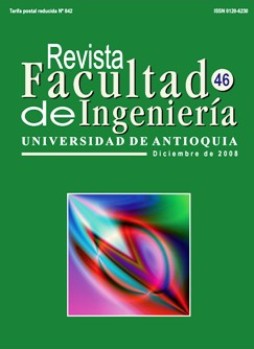Typical demand curvs of electric power for the residential, commercial and industrial sector of Medellin, using artificial neural networks and algorithms of interpolation
DOI:
https://doi.org/10.17533/udea.redin.17934Keywords:
: Artificial neural networks, interpolation algorithms, electric power demandAbstract
One of the main problems for modeling the electric power consumption in a certain place is the extraction of the knowledge when it is stored in big volumes of information like for example historical registrations. According with this representation, each fact happened and registered consists of a couple of components (t, P) where t represents the time of sample registration and P the electric power consumed at that time. The daily registration has N cases that each of the well-known stimulus-answer couples represents. The objective of this work is to develop a function that allows finding the vector of entrance variables t to the vector of exit variables P. F is any function, in this case the electric power consumption. Their modeling with Artificial Neural Netwok (ANN) is Multi a Perceptron Layer (PMC). Another form of modeling it is using Interpolation Algorithms(AI).
Downloads
References
J. Hilera. “Redes Neuronales Artificiales”. Fundamentos, modelos y aplicaciones. Ed. Alfa Omega. Madrid. 2000. pp. 132-153.
B. Martín del Brio. Redes Neuronales y Sistemas Difusos. Ed. Alfa Omega. Madrid. 2002. pp 64 - 69.
T. Masters. Practical Neural Networks recipes in C++. Ed. Academic Press, Inc. San Diego (CA). 1993. pp. 173-180.
R. Burden, F. Duglas. Análisis Numérico. Ed. Thomson Learning. México. 2002. pp. 104-141.
J. Mathews, K. Fink. Métodos Numéricos con Mathlab. 3ª ed. Ed. Prentice Hall. Madrid. 2000. pp. 203-250.
S. Grainger. Análisis de sistemas de potencia. Ed. M. Graw Hill. New York. 2002. pp. 56-124.
R. Dow, J. Sietsman. “Creating Artificial Networks that generalize”. Neural Networks. Vol. 4. pp. 198-209.
Facultad de Ingeniería, Universidad de Antioquia. http://jaibana.udea.edu.co/producciones/programas.html. Consultada el 4 de Marzo de 2007.
Downloads
Published
How to Cite
Issue
Section
License
Revista Facultad de Ingeniería, Universidad de Antioquia is licensed under the Creative Commons Attribution BY-NC-SA 4.0 license. https://creativecommons.org/licenses/by-nc-sa/4.0/deed.en
You are free to:
Share — copy and redistribute the material in any medium or format
Adapt — remix, transform, and build upon the material
Under the following terms:
Attribution — You must give appropriate credit, provide a link to the license, and indicate if changes were made. You may do so in any reasonable manner, but not in any way that suggests the licensor endorses you or your use.
NonCommercial — You may not use the material for commercial purposes.
ShareAlike — If you remix, transform, or build upon the material, you must distribute your contributions under the same license as the original.
The material published in the journal can be distributed, copied and exhibited by third parties if the respective credits are given to the journal. No commercial benefit can be obtained and derivative works must be under the same license terms as the original work.










 Twitter
Twitter